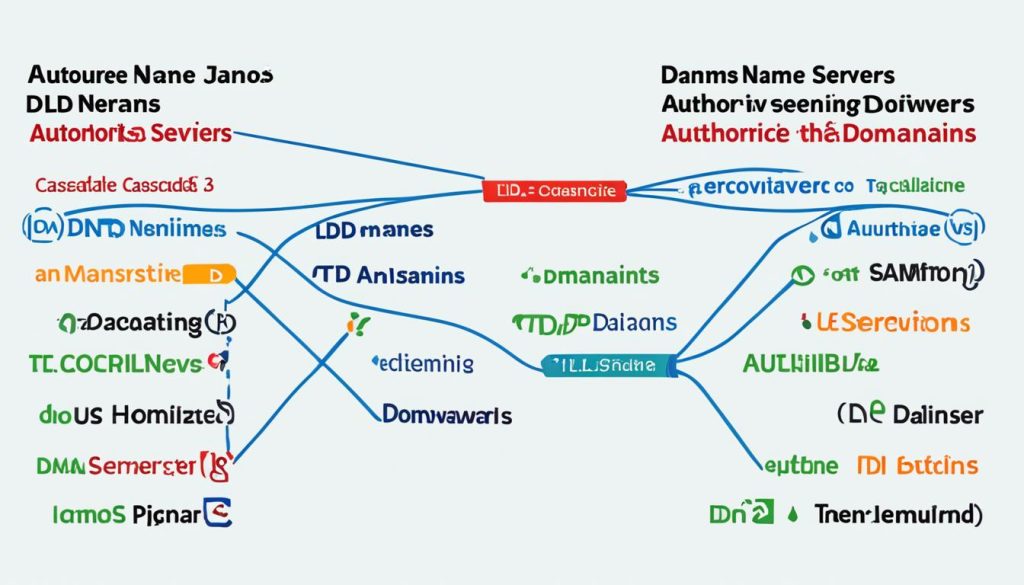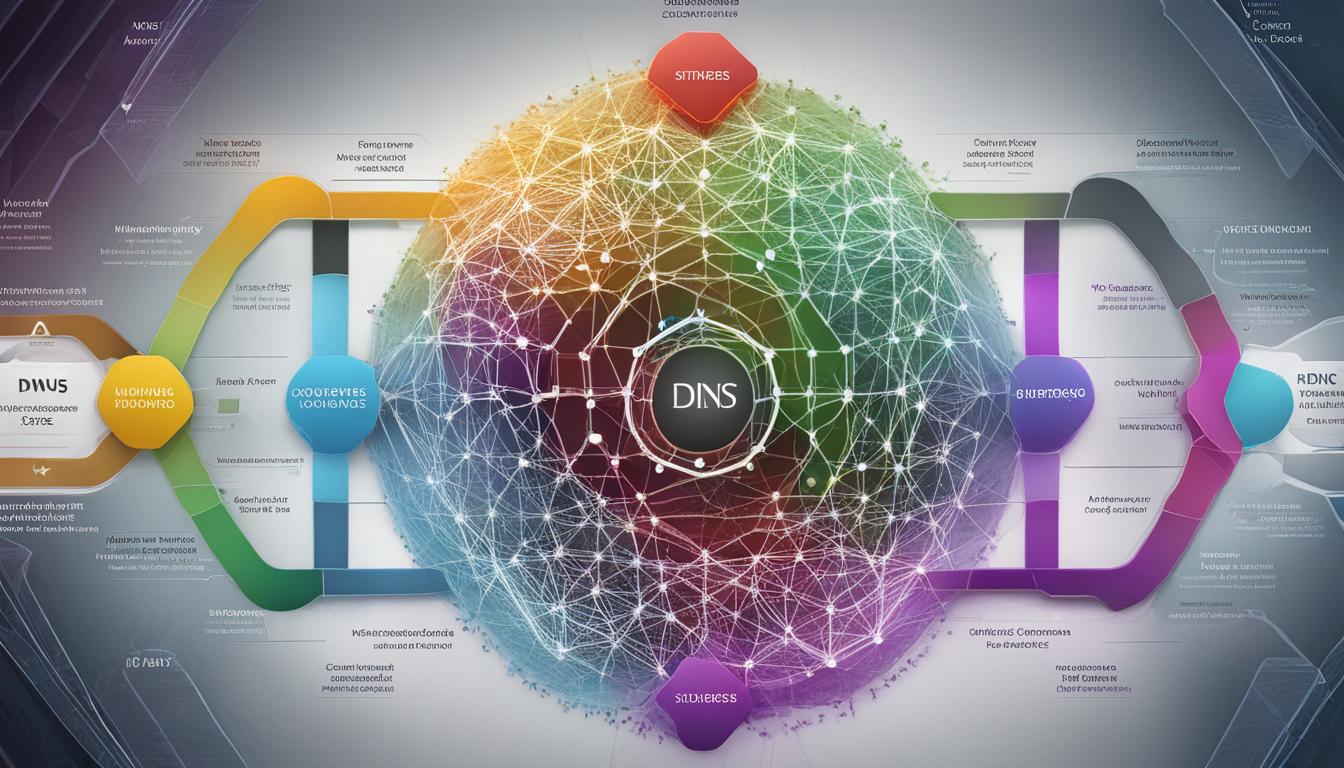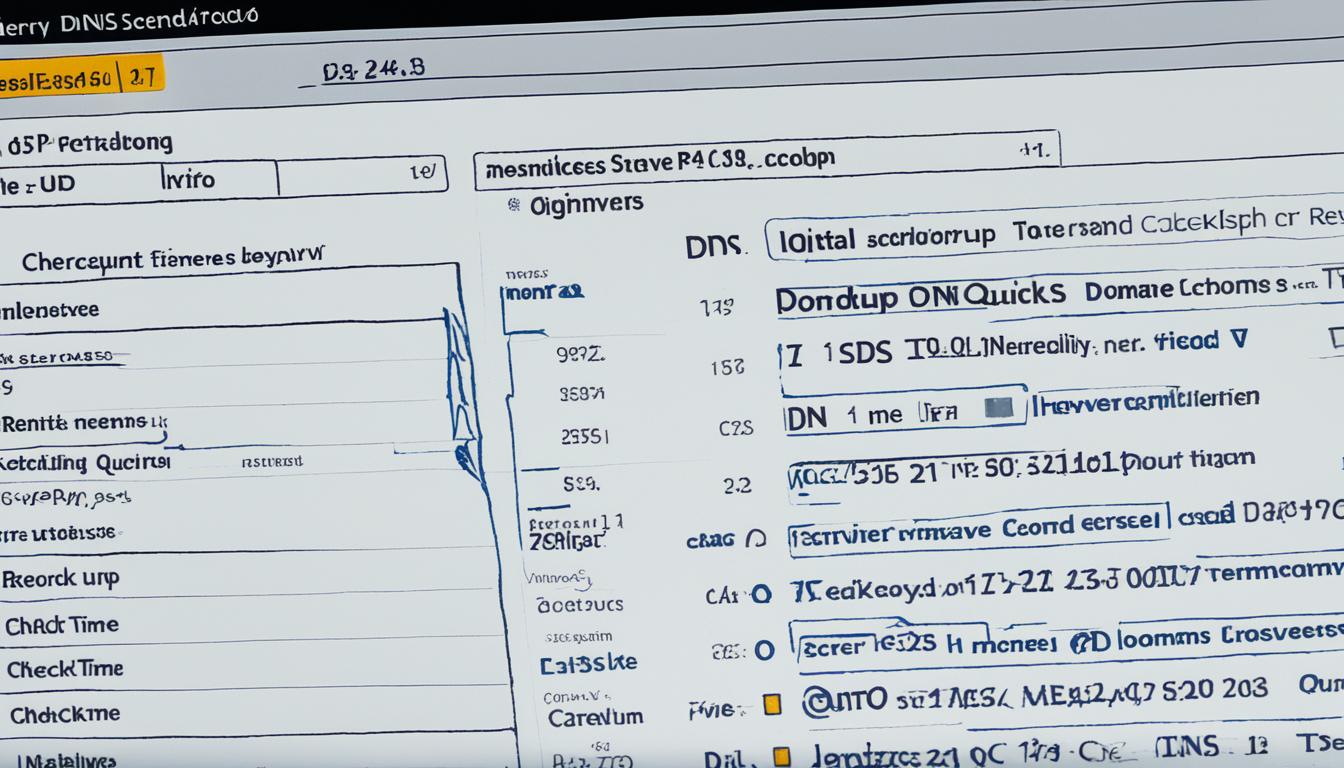DNS zone – What are TLD Name Servers Authoritative for?
Did you know that there are over 1,500 top-level domains (TLDs) on the internet? Each of these TLDs, such as .com, .net, and .org, has its own set of authoritative name servers responsible for providing accurate DNS resolution for domain names within the TLD. The role of TLD name servers is crucial in maintaining the integrity of the DNS zone and ensuring smooth internet navigation.
Key Takeaways:
- TLD name servers are authoritative for specific top-level domains like .com, .net, and .org.
- These servers hold the zone file information for their respective TLDs and provide accurate DNS resolution for domain names under their authority.
- Root name servers delegate control to TLD name servers, allowing them to provide authoritative answers for queries about domain names within their TLD.
- TLD name servers play a crucial role in the internet’s infrastructure, ensuring reliable and seamless internet navigation.
Understanding Authoritative Name Servers
An authoritative name server is the final authority for providing DNS resolution for a specific domain. It holds the original and definitive DNS records for the domain and is responsible for responding to DNS queries with accurate information.
Unlike recursive DNS servers that rely on caching and querying other DNS servers, authoritative name servers have the actual DNS records stored in their systems and directly provide answers to queries about domain names under their authority. These servers ensure that users can access websites and services by correctly resolving domain names to their corresponding IP addresses.
Authoritative name servers play a critical role in the domain name resolution process. When a DNS query is made for a specific domain, it is sent to the authoritative name server responsible for that domain. The authoritative name server then checks its DNS records to provide the correct IP address associated with the requested domain name.
By having direct access to the DNS records, authoritative name servers eliminate the need for additional queries to other DNS servers, resulting in faster and more efficient domain name resolution.
The Role of Root Name Servers
Root name servers play a critical role in the Domain Name System (DNS) by being authoritative for the root zone. While they are not authoritative for specific Top-Level Domains (TLDs), they delegate control to the TLD name servers. Let me explain further.
To understand the role of root name servers, it’s important to grasp the concept of TLD delegation. TLD delegation occurs when the root name servers pass on the responsibility for a specific TLD to its corresponding TLD name servers. This delegation allows for efficient management and distribution of domain name resources throughout the internet.
Additionally, root name servers play a crucial part in ensuring the proper functioning and navigation of the internet. They provide what are known as glue records, which are special records that associate the IP addresses of TLD name servers with their corresponding domain names. These glue records help recursive DNS servers locate and connect with the TLD name servers responsible for specific TLDs.
By maintaining an accurate and up-to-date root zone, root name servers contribute to the stability and reliability of the entire DNS infrastructure. They enable smooth communication between recursive DNS servers, TLD name servers, and authoritative name servers, facilitating seamless internet navigation for users worldwide.

Root Name Server Locations
Root name servers are distributed across various locations worldwide to ensure redundancy and robustness. Currently, there are 13 sets of root name servers, labeled A to M. Each set consists of multiple physical servers strategically placed in geographically diverse locations to enhance the resilience of the DNS system.
The following table provides an overview of the root name server sets and their locations:
| Root Name Server Set | Location |
|---|---|
| A | Verisign, Dulles, Virginia, USA |
| B | Information Sciences Institute, Marina del Rey, California, USA |
| C | Cogent Communications, Herndon, Virginia, USA |
| D | The University of Maryland, College Park, Maryland, USA |
| E | Nominum, Redwood City, California, USA |
| F | Internet Systems Consortium, Inc., Redwood City, California, USA |
| G | US Army Research Lab, Aberdeen Proving Ground, Maryland, USA |
| H | American Internet Registry, Miami, Florida, USA |
| I | Netnod, Stockholm, Sweden |
| J | Verisign, Los Angeles, California, USA |
| K | Royal Institute of Technology, Stockholm, Sweden |
| L | Internet Corporation for Assigned Names and Numbers (ICANN), Los Angeles, California, USA |
| M | WIDE Project, Tokyo, Japan |
These distributed root name servers ensure the availability and redundancy necessary to handle the immense DNS traffic and provide reliable internet navigation for users across the globe.
Recursive DNS Servers and DNS Resolution
When it comes to DNS resolution, recursive DNS servers are an integral part of the process. As a user initiates a DNS query, it is first directed to a recursive DNS server. This server acts as a mediator between the user and authoritative name servers, facilitating the resolution of domain names into their corresponding IP addresses.
Using a process called caching, the recursive DNS server checks its cache to determine if it already has the answer to the query. Caching allows the server to store previously resolved DNS records, improving response times for subsequent queries and reducing reliance on querying other DNS servers every time a request is made.
If the answer is not present in its cache, the recursive DNS server will perform a recursive query to other DNS servers in a hierarchical manner. It begins by querying the root name servers, which hold the information about the top-level domains. The server then proceeds to query the TLD name servers associated with the requested domain, before finally reaching the authoritative name server responsible for that specific domain.
Through this recursive querying process, the DNS server gathers the necessary information to provide an accurate response to the user’s query. This ensures that users can access websites and services by correctly resolving domain names to their respective IP addresses.
The recursive DNS server also plays a significant role in enabling efficient internet browsing. By caching and storing DNS records, it reduces the workload on authoritative name servers and improves overall network performance. This caching mechanism helps minimize latency and enhances the browsing experience for users, especially in scenarios where multiple requests are made for the same domain.
Additionally, recursive DNS servers are often provided by Internet Service Providers (ISPs) as part of their infrastructure. When users connect to the internet through their ISPs, the ISP’s recursive DNS servers handle their DNS queries. This arrangement ensures seamless DNS resolution and efficient internet navigation for users.
By employing recursive DNS servers, the DNS resolution process becomes faster, more efficient, and less burdensome on the internet infrastructure. It plays a vital role in ensuring smooth and seamless internet browsing experiences for users worldwide.
The Importance of DNS in Internet Navigation
The DNS system plays a crucial role in enabling seamless internet navigation. It is the backbone of the internet, allowing users to access websites and services using human-readable domain names, such as umbrella.cisco.com. Without DNS, users would have to remember and manually enter the numeric IP addresses associated with each website, which would not only be inconvenient but also prone to errors.
The DNS system works by translating these human-readable domain names into numeric IP addresses that can be understood by computers. When a user types a domain name into their web browser, the DNS system automatically resolves it to the corresponding IP address, allowing the browser to establish a connection with the website’s server.
At the heart of the DNS system is a hierarchical structure known as the DNS hierarchy. This hierarchy consists of various types of DNS servers that work together to ensure the accurate resolution of domain names.
The DNS hierarchy starts with recursive DNS servers. These servers act as intermediaries between users and the authoritative name servers. When a user sends a DNS query, it first reaches a recursive DNS server. The recursive DNS server then checks its cache to see if it already has the answer to the query. If not, it will recursively query other DNS servers in the hierarchy until it obtains the accurate IP address for the requested domain name.
One of the key components of the DNS hierarchy is the root name servers. These servers are authoritative for the root zone and are responsible for delegating control to the top-level domain (TLD) name servers. TLD name servers, in turn, are authoritative for specific TLDs like .com, .net, and .org. They hold the zone file information for their respective TLDs, including the IP addresses associated with domain names within the TLD.
By following this hierarchical structure, the DNS system ensures the accurate resolution of domain names to their corresponding IP addresses, allowing users to navigate the internet quickly and reliably.
Visualizing the DNS Hierarchy

The image above illustrates the DNS hierarchy, showing the recursive DNS servers, root name servers, TLD name servers, and authoritative name servers. Each level of the hierarchy plays a crucial role in the DNS resolution process, working together to provide accurate and efficient internet navigation.
Cisco Umbrella and Reliable DNS Services
Are you looking for a reliable DNS service that ensures fast and secure internet connectivity? Look no further than Cisco Umbrella. With their highly resilient network of recursive DNS servers, they provide a seamless experience for organizations.
One of the key benefits of Cisco Umbrella is their use of anycast routing. This intelligent routing directs DNS queries to the nearest and fastest available data center, ensuring reliable and uninterrupted connectivity. Whether you’re accessing websites or using cloud-based services, Cisco Umbrella guarantees a smooth experience.
In addition to offering reliable connectivity, Cisco Umbrella places a strong emphasis on DNS security. Their comprehensive DNS service protects organizations from potential security threats, ensuring that your network remains secure and your data is safeguarded.
When it comes to ensuring smooth and secure internet access, Cisco Umbrella is the trusted choice. With their reliable recursive DNS service and commitment to uptime, organizations can enjoy seamless connectivity and peace of mind. Try Cisco Umbrella today and experience the difference for yourself!
FAQ
What is the role of TLD Name Servers in a DNS zone?
What are Authoritative Name Servers and how do they work?
What is the role of Root Name Servers in the DNS hierarchy?
How do Recursive DNS Servers contribute to DNS resolution?
Why is DNS important for internet navigation?
How can Cisco Umbrella’s recursive DNS service help ensure reliable internet connectivity?
- Shop for Server & Workstation Systems & more - February 25, 2025
- IP Geolocation API and IP Location Lookup Tools - February 24, 2025
- What is GoDaddy? Everything You Need to Know in 2024 - February 23, 2025





















Post Comment
You must be logged in to post a comment.